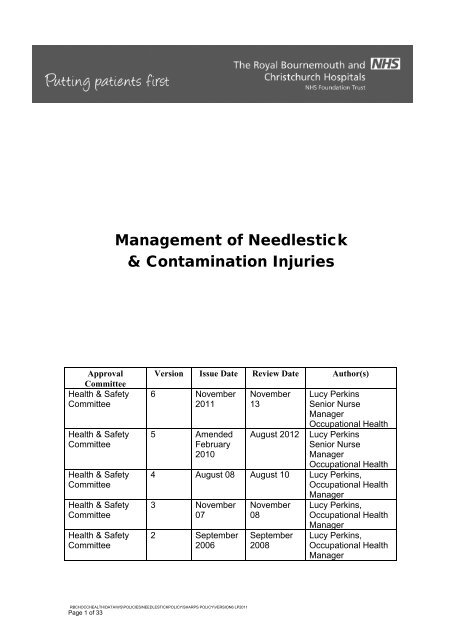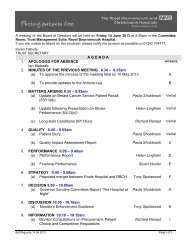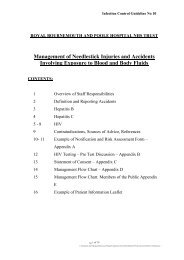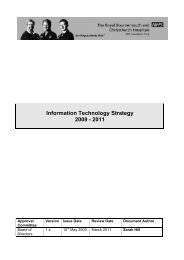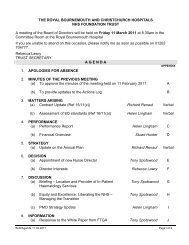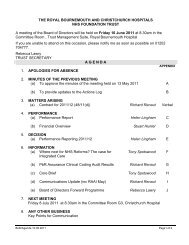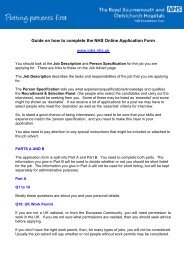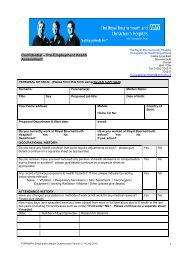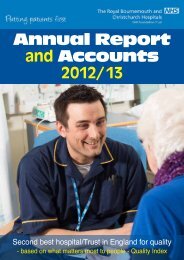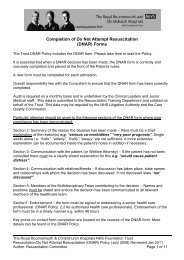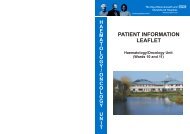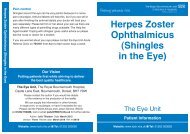Management of Needlestick & Contamination Injuries - Royal ...
Management of Needlestick & Contamination Injuries - Royal ...
Management of Needlestick & Contamination Injuries - Royal ...
- No tags were found...
You also want an ePaper? Increase the reach of your titles
YUMPU automatically turns print PDFs into web optimized ePapers that Google loves.
<strong>Management</strong> <strong>of</strong> <strong>Needlestick</strong>& <strong>Contamination</strong> <strong>Injuries</strong>ApprovalCommitteeHealth & SafetyCommitteeHealth & SafetyCommitteeHealth & SafetyCommitteeHealth & SafetyCommitteeHealth & SafetyCommitteeVersion Issue Date Review Date Author(s)6 November20115 AmendedFebruary2010November13August 2012Lucy PerkinsSenior NurseManagerOccupational HealthLucy PerkinsSenior NurseManagerOccupational Health4 August 08 August 10 Lucy Perkins,Occupational HealthManager3 November072 September2006November08September2008Lucy Perkins,Occupational HealthManagerLucy Perkins,Occupational HealthManagerRBCHOCCHEALTH\DATA\WS\POLICIES\NEEDLESTICKPOLICY\SHARPS POLICY\VERSION6 LP2011Page 1 <strong>of</strong> 33
VERSION CONTROLVersion Date Author Section5 Feb 2010 LP 9.06 November2011LPVariousPrinciple AmendmentChangesMonitoring section amended to ensurecompliance with NHSLA Level 2 standardsfor Acute Trusts.Amendments and clarification <strong>of</strong> processCONSULTATION PROCESSVersion Date Author Level <strong>of</strong> Consultation5 Feb 2010 LP Minor amendments to ensure compliance with NHSLA Level 3standards, so consultation limited to Risk Department &Occupational Health prior to approval.6 November2011LPMajor amendments and clarification <strong>of</strong> processRBCHOCCHEALTH\DATA\WS\POLICIES\NEEDLESTICKPOLICY\SHARPS POLICY\VERSION6 LP2011Page 2 <strong>of</strong> 33
CONTENTS:SectionsPage Nos1.0 Flow chart - emergency management <strong>of</strong> <strong>Needlestick</strong>s <strong>Injuries</strong> 42.0 Policy Statement 53.0 Definitions 64.0 Roles and Responsibilities 65.0 Risk Assessment and Risk Control 86.0 Safe Sharps Practice 87.0 <strong>Management</strong> <strong>of</strong> <strong>Needlestick</strong> Incident and Accidents 98.0 Training and Promotion <strong>of</strong> Safe Sharps Practice 159.0 Monitoring 1610.0 Review 1711.0 References 17Appendix AOccupational Health/Accident and Emergency Incident RecordForm for <strong>Needlestick</strong> <strong>Injuries</strong>18Appendix B HIV Testing -Pre Test Discussion 20Appendix C Statement <strong>of</strong> Consent 21Appendix D <strong>Management</strong> <strong>of</strong> High Risk Exposure Flow Chart 22Appendix E Example <strong>of</strong> Information Leaflet 23Appendix F Advice & Support for Staff Following a <strong>Needlestick</strong> 24Appendix GTerms <strong>of</strong> Reference for the Sharps Injury Prevention and<strong>Management</strong> Group25Appendix H Sharps Injury Prevention & <strong>Management</strong> Group 29EIA 32RBCHOCCHEALTH\DATA\WS\POLICIES\NEEDLESTICKPOLICY\SHARPS POLICY\VERSION6LP2011Page 3 <strong>of</strong> 33
Emergency <strong>Management</strong> <strong>of</strong> <strong>Needlestick</strong> <strong>Injuries</strong> and Accidentsinvolving exposure to blood and body fluids flowchartExposure to Blood and/or Body Fluids1. Wash / clean affected area / encourage to bleed. Do not suck.2. Notify Duty Manager (Bleep 2002).3. Go to Occupational Health immediately, if out <strong>of</strong> hours attend EmergencyDepartment immediately.4. Complete AIRS form.5. Have blood sample taken for storage.Further action depends on risk assessment. See policy and guidance below.Staff immuneProtective level documented. No action requiredHepatitis Bpositive patientStaff not vaccinatedReceive 1 st dose Hep. B plus Hep B immunoglobulin within48 hours (via on-call Microbiology Consultant RBCH)Staff vaccinated but unsure <strong>of</strong> statusHepatitis B Booster serum store and Anti-HBs (2 monthslater)HIV positivepatientSeek immediate adviceFollow flowchart Appendix DHepatitis CpositivepatientsSerum Store requiredDiscuss with Occupational Health.PatientsHepatitis B or Cor HIV statusunknownDonor /-Arrange for Donor to be tested for Hep B, C and HIVfollowing appropriate consent. This must be recorded inpatient’s notesRBCHOCCHEALTH\DATA\WS\POLICIES\NEEDLESTICKPOLICY\SHARPS POLICY\VERSION6LP2011Page 4 <strong>of</strong> 33
2.0 POLICY STATEMENT<strong>Royal</strong> Bournemouth and Christchurch Hospitals NHS Foundation Trust recognises itsresponsibilities and duties under the Health Act 2006 and the Health and Safety at Workregulations. The Trust is committed to ensuring, so far as is reasonably practicable, theHealth, Safety and Welfare <strong>of</strong> its staff, patients, visitors and other persons who may beaffected by its activities.<strong>Royal</strong> Bournemouth and Christchurch Hospitals NHS Foundation Trust recognises thatinjuries caused by Needles and Sharp instruments account for a significant number <strong>of</strong>injuries within the NHS. Every <strong>Needlestick</strong> injury has the potential to cause seriousharm. These sharp devices may have been in contact with infected blood borne viruses(BBV) such as Hepatitis B, C and HIV.<strong>Royal</strong> Bournemouth and Christchurch Foundation Trust is committed to ensuring thatthe risk <strong>of</strong> injury from Sharps is reduced to the lowest possible level. This will beachieved by promoting safe sharp practice and the use <strong>of</strong> safer sharps devices.In the event <strong>of</strong> a sharps injury, the Trust will endeavour to reduce the effects <strong>of</strong> thatinjury to the absolute minimum.Preventing sharps injuries and the related prevention <strong>of</strong> infection are health and safety,risk management and clinical governance issues. All employers in the NHS have legalobligations under the Health and Safety at Work Act 1974 (HSWA). They have a duty toprotect their staff and others that may be affected by their work such as contractors,agency staff, patients and visitors. Under the HSWA, employers must ensure that theirstaff are appropriately trained and pr<strong>of</strong>icient in the procedures necessary for workingsafely.The <strong>Management</strong> <strong>of</strong> Health and Safety at Work regulations 1999 places a duty on theemployer to provide a workplace that is, so far as is reasonably practicable, without riskto health or safety.The Control <strong>of</strong> Substances Hazardous to Health (COSHH) regulations 2002 includesrisks relating to health and including a specific duty in relation to micro-organisms e.g.bacteria and viruses etc.Any person handling a sharp therefore, has a clear mandatory duty to ensure that everyprecaution is taken to prevent an Injury to themselves or others.The purpose <strong>of</strong> this Policy is to <strong>of</strong>fer advice and guidance on safe sharp practices inorder to prevent or reduce the number <strong>of</strong> sharps injuries to the lowest practical level.RBCHOCCHEALTH\DATA\WS\POLICIES\NEEDLESTICKPOLICY\SHARPS POLICY\VERSION 6 LP 2011Page 5 <strong>of</strong> 33
3.0 DEFINITIONS<strong>Needlestick</strong> & <strong>Contamination</strong>For the purposes <strong>of</strong> this guideline <strong>Needlestick</strong>s are defined as objects that carry the risk<strong>of</strong> transmission <strong>of</strong> blood borne viruses. This could include suture needles, hollowneedles, scalpels, razors, sharp edged or pointed surgical instruments, broken glass orany sharp object or material that breaches the natural skin barrier. Sharp tissue such asbone or teeth may also pose a risk <strong>of</strong> injury.<strong>Contamination</strong> injuries are defined as any exposure <strong>of</strong> body fluids into the mucousmembranes i.e. nose mouth etc.4.0 ROLES AND RESPONSIBILITIESAll staff are responsible for compliance with procedures for the prevention andmanagement <strong>of</strong> needlestick injuries and accidents involving exposure to blood and bodyfluids.4.1 Managers (Clinical Leaders & Heads <strong>of</strong> Department)Managers have the duty to ensure that there is a "Safe System <strong>of</strong> Work" and that allnecessary equipment for the safe use and handling <strong>of</strong> sharps, such as sharp boxes andsharps trays etc are readily available for use.Managers are responsible for ensuring that a safe environment is provided for patientsand visitors. This includes ensuring that appropriate arrangements are in place toensure that sharps are disposed <strong>of</strong> securely and correctly and that sharps boxes are notaccessible to non-members <strong>of</strong> staff.Managers are responsible for completing COSHH Assessments to identify potentialrisks <strong>of</strong> microbiological and chemical hazards and ensuring that appropriate action plansand arrangements are in place to prevent or control exposure to identified risks.Managers are responsible for completing local Risk Assessments (in accordance withthe Trust Risk Assessment Policy) to identify potential risks <strong>of</strong> needlestick or sharpsinjuries. (See Section 5.0)Managers are responsible for monitoring exposure and for investigating reportedadverse incidents, including near miss events. Incidents must be reported andinvestigated in accordance with the Trust Accident and Incident Reporting Policy (AIR)and managers must report RIDDOR incidents immediately to Occupational Health,Clinical Governance & Risk <strong>Management</strong> DepartmentsManagers are responsible for ensuring personal protective equipment is in place andworn by staff for any procedure identified as hazardous (i.e. contact with a blood bornevirusRBCHOCCHEALTH\DATA\WS\POLICIES\NEEDLESTICKPOLICY\SHARPS POLICY\VERSION 6 LP 2011Page 6 <strong>of</strong> 33
4.2 Sharp Injury Prevention and <strong>Management</strong> GroupThe Sharps Group is a sub working group established by and reportable to the Healthand Safety Committee.Purpose <strong>of</strong> the group is;• To work together to promote a safer working environment for all staff includingexternal contractors, visitors, etc.• To monitor the effectiveness <strong>of</strong> the Trust’s policies and procedures, in particularthose relating to sharps injuries and blood and body fluid injuries for the well being <strong>of</strong>staff including external contractors, visitors, etc.Key Responsibilities• To discuss activity within each department and review and monitor number and type<strong>of</strong> incidents reported.• To review compliance with Trust processes and procedures, including those forsupporting staff as a result <strong>of</strong> incidents and other adverse events.• To review how action can be taken forward, e.g. training, reporting, audit, guidance,protocols and policies.• To ensure issues/problems arising from the above are communicated to the Health& Safety Committee on a quarterly basis.• The Group serves to ensure that there is an effective framework within whichassurances can be given in relation to needlestick/contamination prevention andmanagement.• The Committee Chairman shall be the Occupational Health Nurse Manager.4. 3 Staff Responsibilities• All staff must carry out work activities in accordance with the training they havereceived and by following safe working practices. Staff have a duty to familiarisethemselves with the Foundation Trust’s Policy and to comply with systems andprocedures put in place by the Trust in order to ensure the health, safety and welfare<strong>of</strong> themselves and others.• Staff are required to share best practice when dealing with equipment that has thepotential to cause a sharps injury. Staff are encouraged to use all safety equipmentsupplied by the Trust, sharps bins and safety devices. They are required to inform theirline managers <strong>of</strong> any unsafe practices or hazards they identify.• If any employee is in any doubt about a safe sharp procedure, they must seek advicefrom their line manager before commencing that procedure. The Occupational HealthDepartment, Infection Control and Pr<strong>of</strong>essional Development Department can answerquestions or provide training for any member <strong>of</strong> staff who is unsure about safe sharppractice.RBCHOCCHEALTH\DATA\WS\POLICIES\NEEDLESTICKPOLICY\SHARPS POLICY\VERSION 6 LP 2011Page 7 <strong>of</strong> 33
• All staff are responsible for reporting any hazards, risk issues (e.g. insufficient sharpsbins), and adverse incidents to their line manager. All incidents must be reported inaccordance with the Trust AIR Policy.• All staff are required to attend mandatory training on a bi-annual basis.• Where English is not the persons first language or if any other interpreter is required• Please refer to the interpreting policy• All staff are responsible for wearing appropriate personal protective equipment (i.e.visors, masks, gloves, aprons, where advised to by their manager for control <strong>of</strong>contamination with a blood borne virushttp://rbhintranet/policies/corporate/interpreting.pdf5.0 RISK ASSESSMENT AND CONTROL• Managers are responsible for considering needlestick and exposure to body fluidrisks when undertaking risk assessments <strong>of</strong> the workplace. The risk assessmentmust be undertaken in accordance with the Trust Risk Assessment Policy.• The risk assessment must identify the arrangements in place to enable safehandling <strong>of</strong> sharps and contamination incidents. The risk assessment must be madeavailable to all staff. Bi -annual mandatory training provides an education forum toupdate all Trust staff.• Where the risk assessment identifies uncontrolled or unacceptable levels <strong>of</strong> risk thena risk control action plan must be implemented. Where control measures cannot beimmediately implemented then such issues must be placed on the Directorate RiskRegister.6.0 SAFE SHARPS PRACTICE• The level <strong>of</strong> precautions to be taken for any procedure must be determinedaccording to the extent <strong>of</strong> possible exposure to blood and/or bodily fluids.• It is the recommended practice to take a sharps tray with sharps bin to the patient inorder to facilitate safe disposal.• Always use an appropriately sized sharps box.• Promptly dispose <strong>of</strong> used needles in an approved sharps disposal container, avoidhandling <strong>of</strong> such devices by a second person.• All Sharps bins or boxes must comply with UN33291. The current supplier is 'DanielsHealthcare'. The products range from a ½ litre capacity to 22 litres. All are yellow incolour and have red lids. – Cytotoxic have purple lids.• Always take the sharps bin to the patient and dispose <strong>of</strong> at the point <strong>of</strong> use, placingthe sharp end into the bin first.• Use the temporary closure mechanism following disposal <strong>of</strong> the sharp.RBCHOCCHEALTH\DATA\WS\POLICIES\NEEDLESTICKPOLICY\SHARPS POLICY\VERSION 6 LP 2011Page 8 <strong>of</strong> 33
• All sharps boxes must be sited as close as practical to where the sharp is to beused, but not left within reach <strong>of</strong> children or adults who may be at risk. In this instant,the position <strong>of</strong> a sharps bin is subject to a risk assessment.• Where persons may be at risk, the 'Daniels Sharps guard' must be used which has atilting mechanism to prevent fingers or small hands entering the bin.• Always carry sharps boxes by the handle• Where permanent sites are required, sharps bins must always be mounted on abracket either on a fixed wall surface or trolley. Syringes and needles must bedisposed <strong>of</strong> intact.• Do not fill sharps boxes more than ⅔ full.• Do not try to retrieve anything from a sharps box.• Lock the used sharps boxes when ready for final disposal and ensure that theclinical area is identifiable in writing in accordance with the manufacturer'sinstructions on the bin. Ensure the appropriately coded sealing tape is used toidentify the box.• Dispose <strong>of</strong> sharps boxes according to Trust Policy. The Waste <strong>Management</strong> Policyspecifies how all hospital waste, including sharps is to be safely disposed. A copycan be found on the Trust's Intranet. Do not dispose <strong>of</strong> sharps with other clinicalwaste, or place in yellow bags for disposal.• Do not resheath needles.6.1 Use <strong>of</strong> GlovesAll staff must wear gloves for venepuncture and insertion <strong>of</strong> any intravascular device.Gloves will not prevent percutaneous injury but they may reduce the risk <strong>of</strong> acquiring aBlood Borne Virus (BBV) infection. Although punctured gloves allow blood tocontaminate the hand there is evidence to show a reduction in the volume <strong>of</strong> bloodinoculated in the event <strong>of</strong> a percutaneous injury (Mast el al, 1993).7.0 MANAGEMENT OF NEEDLESTICK/ CONTAMINATION INCIDENTSFor Immediate management <strong>of</strong> an inoculation incident, refer also to the flow chart onpage 4.7.1 Immediate First AidFor ALL exposures:a) Skin puncture wounds from used and potentially contaminated needles orinstruments must be encouraged to bleed and then immediately washedthoroughly (but not scrubbed) with soap and water. Do not suck the wound.b) Splashes <strong>of</strong> blood or body fluid into the mouth must be washed out thoroughlywith copious amounts <strong>of</strong> tap water immediately.c) Splashes <strong>of</strong> blood or body fluids in to the eyes must be well irrigated with a normalsaline eyewash or running water immediately. Contact lenses must be removedand not reapplied until checked or changed by your opticianRBCHOCCHEALTH\DATA\WS\POLICIES\NEEDLESTICKPOLICY\SHARPS POLICY\VERSION 6 LP 2011Page 9 <strong>of</strong> 33
7.2 <strong>Management</strong> <strong>of</strong> incidents during normal working hours (08.00-17.00)During normal opening hours Occupational Health will provide advice and assist in themanagement <strong>of</strong> incidents involving staff. Visitors involved in such incidents shouldattend Emergency Department (ED). A decision about the need for post-exposureprophylaxis can then be made based on the level <strong>of</strong> risk. An information leafletoutlining the possible side effects <strong>of</strong> the prophylactic drugs and how to obtain followup treatment and advice must be given to the exposed person.7.2.1 If there is a risk <strong>of</strong> exposure to HIV, Post Exposure Prophylaxis (PEP) must bestarted immediately, preferably within one hour, following consultation with the oncall GUM Physician.It must be noted that these anti-retroviral drugs are not licensed for incidents involvingtheir use as prophylaxis against HIV infection and a disclaimer must be signed by therecipient (Appendix C).These drugs are prescribed on “a named patient basis”. The recipient must be advisedabout possible short-term side effects.The immediate PEP will be dispensed in an initial 3 day treatment pack containing therecommended anti-retrovirals. The remaining course will be prescribed at the follow upassessment, which must be arranged through the GUM Department. The initial PEPtreatment packs will be available in Pharmacy and EMERGENCY DEPARTMENT <strong>Royal</strong>Bournemouth and Poole Hospital.(i)(ii)If the HIV status <strong>of</strong> an identified high risk source is unknown, it may be necessaryto commence PEP pending further risk assessment, discussion and testing.Source patients must be tested for HIV antibodies provided informed consent hasbeen obtained.With an unidentified source, eg. a discarded syringe and needle, PEP would notnormally be indicated.(iii)(iv)If the recipient is a child, dosages must be discussed with a paediatrician/pharmacist.If the source patient is or has been on anti-retroviral treatment, alternative drugregimens may need to be considered. (Contact the HIV physician, GUM physicianon-call).It is Trust Policy that needlestick accidents must be reported and investigated urgentlyand that PEP must be given within one hour <strong>of</strong> exposure. However, if there is a delayin reporting a high risk exposure, it may be worth considering PEP up to 72 hours fromexposure.7.2.2 Patient (exposed person) counselling and follow upFor exposures assessed as significant and with a source known or strongly suspectedto be HIV positive:-(i)Initial post exposure management and counselling in OHD and EMERGENCYDEPARTMENTRBCHOCCHEALTH\DATA\WS\POLICIES\NEEDLESTICKPOLICY\SHARPS POLICY\VERSION 6 LP 2011Page 10 <strong>of</strong> 33
must include: assurance <strong>of</strong> confidentiality reassurance that transmission risk is low the possibility for post-exposure prophylaxis the risk <strong>of</strong> toxicity <strong>of</strong> PEP and the need for regular medical follow-up obtaining a blood specimen (5-10ml serum) from exposed person for storage management <strong>of</strong> hepatitis B, hepatitis C and other risks appropriately arrangement <strong>of</strong> follow-up appointment for monitoring and counselling in theGUM Dept., RBH. If the patient needs further immediate counselling contact aGUM Health Adviser. Obtain bloods for FBC, LFTs, U&Es, before PEP is started. Pregnancy test may need to be done before starting PEP. Patients on PEP need monitoring <strong>of</strong> FBC, LFTs and U+Es at 1, 2 and 4 weeksin the GUM department. Confirmation that an incident form has been completed.(ii)Post exposure follow-up by Occupational Health/GUM RBH. emphasise the need for pre-HIV test discussion and the availability <strong>of</strong> furtheradvice and support monitor effects <strong>of</strong> prophylaxis if given emphasise the need for follow-up at 3 months and 6, 12 months postexposure, with HIV testing and serum storage emphasise the need to report interim illness explain the need to prevent further possible transmission (protected sexualintercourse, avoidance <strong>of</strong> pregnancy, blood, organ and semen donation) with health-care workers, provide reassurance that in general, work restrictionsduring follow-up are not appropriate report management and outcome to the Health Protection Unit7.2.3 ContraindicationsAny renal or hepatic insufficiency is a relative contraindication. Pregnancy requiresspecific specialist consultation before starting treatment. Refer to on-call GUM Physicianif out <strong>of</strong> hours.All exposed persons will require follow up. Those taking triple therapy and prophylaxisfollowing exposure to HIV should be aware that regular virological, clinical andhaematological monitoring whilst taking drug and at intervals for six months thereafter isrecommended. This will be co-ordinated by the Genito-urinary Medicine Department,RBCH.Further help on medications can be obtained from the HIV Pharmacist - 01202 704095.7.2.4 Further ActionSubsequent action will depend on the nature <strong>of</strong> the exposure and the likelihood <strong>of</strong> the‘source’ being a high risk group for Hepatitis or HIV Infection.If the source belongs to a recognised high risk group the administration <strong>of</strong> hepatitis Bimmunoglobulin (HBIG) plus hepatitis B vaccine may be indicated before blood testresults are known. Advice should be sought from the Medical Microbiologists prior toRBCHOCCHEALTH\DATA\WS\POLICIES\NEEDLESTICKPOLICY\SHARPS POLICY\VERSION 6 LP 2011Page 11 <strong>of</strong> 33
initiating the above and or the on call GUM physician. If the source is unknown advicemay also be sought on the management <strong>of</strong> the case.A 6ml clotted blood sample (red top) must be obtained from the injured or exposedperson and stored in the Microbiology Department at Poole for future testing ifnecessary. NB. Whenever samples are taken from the exposed person where possiblegive details <strong>of</strong> the hepatitis B vaccination history on the request form.7.3 Procedures for acting upon Hepatitis B source needlestickAction required:Source HBsAg Negative: no further action necessary.Source HBsAg Positive7.3.1 Exposed person already received a full course <strong>of</strong> Hepatitis B Vaccine• If hepatitis B antibody (anti - HBs) level known to be > 100 iu/ml and a booster dosehas been given 5 years after the primary course, no further action is needed (longterm immunity can be assumed).• If it is more than 5 years since the primary course was given, but the 5 year boosterdose has not been given, it must be given now.• If the post primary vaccination course antiHBs level is unknown but the course hasbeen completed in the last 6 months check the Anti-Hbs level, if the course hasbeen completed more than 6 months Hepatitis B Booster is indicated with are-check <strong>of</strong> the anti-HBs level 2 months later.7.3.2 Exposed person not vaccinated• Start course <strong>of</strong> hepatitis B vaccine.• Hepatitis B immunoglobulin (HBIG) must be given as soon as possible afterexposure and certainly within 48 hours. This must be given at a different site to theHepatitis B vaccine. HBIG is available from Pharmacy. HBIG must be given as soonas possible after exposure and preferably within 48 hours. It is <strong>of</strong> no value later thanone week after exposure. (Any concerns seek advice from microbiologists)RBCHOCCHEALTH\DATA\WS\POLICIES\NEEDLESTICKPOLICY\SHARPS POLICY\VERSION 6 LP 2011Page 12 <strong>of</strong> 33
7.3.3 Exposed person vaccinated but not completed full course• Hepatitis B Booster is indicated with a re-check <strong>of</strong> the anti-HBs level 2 months later.Refer to OHD when re-opens7.4 Procedures for acting upon Hepatitis C source needlestickThere is no specific prophylaxis or vaccination available against Hepatitis C. There istherefore no immediate action, which needs to be taken following exposure to a possiblesource with Hepatitis C infection. However exposed health care workers must bemanaged as follows:7.4.1 Known Hepatitis C infected source• On initial assessment which may be in ED if out <strong>of</strong> hours obtain baseline serum forstorage from health care worker• Obtain clotted blood sample (serum) for HCV RNA testing at 6 and 12Weeks (during OHD follow up)• Obtain serum for HCV antibody (anti-HCV) at 12 and 24 weeks (during OHDfollow up)7.4.2 Hepatitis C status <strong>of</strong> source unknown• Obtain baseline serum for storage from health care worker refer to OHD as soon as itre opens for follow up.7.5 Incidents outside <strong>of</strong> normal working hours7.5.1 Clinical Site Team• Outside <strong>of</strong> normal working hours the Clinical Site Team shall provide advice on themanagement <strong>of</strong> Inoculation Incidents. The Clinical Site team shall:• Ensure the healthcare worker is facilitated through the EMERGENCYDEPARTMENT, Triaged within 30 minutes <strong>of</strong> attendance in order that whereindicated PEP can be commenced within the hour from exposure.• Attempt to determine any risk factors <strong>of</strong> source patient.• Approach the source patient and explain the incident. Obtain verbal consent fortesting and document accordingly. Guidance for the clinician can be found atAPPENDIX B HIV TESTING: PRE TEST DISCUSSION• Ensure an AIRS form is completed for all incidents.7.5.2 Out <strong>of</strong> hour’s advice on HIV issuesThe on call HIV Consultant must be contacted. There is always a consultant on call fortelephone advice regarding <strong>Needlestick</strong>s and <strong>Contamination</strong> incidents and PostExposure Prophylaxis (PEP) contactable through switchboard. Emergency Departmentare able to initiate PEP also.7.5.3 EMERGENCY DEPARTMENTRBCHOCCHEALTH\DATA\WS\POLICIES\NEEDLESTICKPOLICY\SHARPS POLICY\VERSION 6 LP 2011Page 13 <strong>of</strong> 33
Within the Emergency Department the Triage Nurse is responsible for: Fast tracking patients to medical staff within 30 minutes <strong>of</strong> attendance in theEmergency Department Completing a risk assessment form (Appendix A) and send it immediately to theOccupational Health Department (by fax on 4513 or hand).If PEP is to be commenced, discussing this with GUM/HIV physician on call. If PEPgiven, arrange follow up with GUM Advisors.Determining the Hepatitis B status <strong>of</strong> healthcare worker and considering (HepatitisImmunoglobulin obtained through on call microbiologist HBIG)Taking a clotted sample from healthcare worker for serum storage (red top bottle).Providing initial reassurance and support to the healthcare worker.Emergency Department will complete the Notification form attached at Appendix Aand send to Occupational Health immediately for ongoing management <strong>of</strong> the injuryto the staff member.7.6 <strong>Management</strong> <strong>of</strong> source patientIt is the responsibility <strong>of</strong> the Medical or Surgical Team looking after the patientconcerned (whether that be as an Out patient, Day surgery Patient or in Patient) to takethe lead on managing source patient. This must involve working in partnership with theOccupational Health Department, Genito Urinary Medicine Department and MultidisciplinaryTeam (to include Consultant Microbiologist at times) involved in looking afterthe patient. A positive HIV, Hepatitis B or C test should result in appropriatemanagement <strong>of</strong> both patient and healthcare worker.When the source (usually a patient) <strong>of</strong> the contaminated sharp or material is known,blood must be taken with informed consent for Hepatitis B, C, and HIV antibodyscreening from the source. Consent must be documented in the patient’s notes. Pretestdiscussion must be carried out prior to obtaining blood sample. The sample shouldnot be taken by the needlestick recipient (see Appendix B and C). Request forms mustbe signed.HIV Counselling can be done by the HIV health advisors in certain circumstances.At the time that the blood sample is taken the person responsible for managing andcommunicating the results must be decided and agreed. (All blood results on the donormust be copied to Consultant in charge <strong>of</strong> patient care and Occupational HealthDepartment.)If the patient has been discharged home all reasonable attempts must be made to followthis policy and to liaise with the General Practitioner and or Practice Nurse <strong>of</strong> the donormust be followed. It must be evidenced that all reasonable attempts have been made t<strong>of</strong>ollow the Trust policy.7.6.1 Source patients without capacity to give consent, or unconscious patientsRBCHOCCHEALTH\DATA\WS\POLICIES\NEEDLESTICKPOLICY\SHARPS POLICY\VERSION 6 LP 2011Page 14 <strong>of</strong> 33
Unconscious patients, or those without capacity to consent, may be tested for seriouscommunicable diseases, without their prior consent, ONLY where testing would be intheir immediate clinical interests – for example, to help in making a diagnosis.7.6.2 <strong>Injuries</strong> to health care workers involving source patients without capacityIf a health care worker has suffered a needle-stick injury or other occupational exposureto blood or body fluids and it is considered necessary to test the patient for a seriouscommunicable disease, the patient’s consent should be obtained before the test isundertaken. If the patient is unconscious when the injury occurs consent should besought once the patient has regained full consciousness. If appropriate, the injuredperson can take prophylactic treatment until consent has been obtained and the testresult is known.If the patient refuses testing, is unable to give or withhold consent because <strong>of</strong> mentalillness or disability, or does not regain full consciousness within 48 hours, the severity<strong>of</strong> the risk should be reviewed by the Senior Consultants involved in the patient’s case.It should be understood that testing without consent may have legal ramifications.RBCHOCCHEALTH\DATA\WS\POLICIES\NEEDLESTICKPOLICY\SHARPS POLICY\VERSION 6 LP 2011Page 15 <strong>of</strong> 33
8.0 TRAINING & PROMOTION OF SAFE SHARPS PRACTICEStaff will receive information and training on waste management, including proceduresfor the safe use <strong>of</strong> sharps and needlestick procedures, as part <strong>of</strong> corporate and localinduction.Staff will receive additional training and advice in relation to sharps safety andneedlestick reporting procedures as necessary via their line manager, for example aspart <strong>of</strong> mandatory training, as part <strong>of</strong> an AIR investigation or, as part <strong>of</strong> a team briefing.Sessions may also be arranged via Occupational Health on request.All training must be recorded on ESR.Managers will receive training in risk management; the Trust has accreditation and runsIOSHH Risk <strong>Management</strong> in Healthcare Course.9. 0 MONITORINGThe Trust Sharps Injury Prevention and <strong>Management</strong> Group will monitor and reviewsharps injuries quarterly and report back to the Health & Safety Committee. Details <strong>of</strong>the indicators to be reported are included within the terms <strong>of</strong> reference for the SharpsPrevention Group (See Appendix G). Feedback from the National Staff Survey which iscarried out on an annual basis will also be fed back to the Sharps Prevention Group andreported back to the Health and Safety Committee on an annual basis.Data from AIR forms will be provided from Risk <strong>Management</strong> department quarterlyworking in conjunction with the Occupational Health Department and discussed at theSharps Prevention Group (see Appendix G). Trends identified will be investigated andappropriate recommendations made to reduce the risks associated to the lowest extentreasonably practicable.An annual Waste <strong>Management</strong> Audit (to include availability and use <strong>of</strong> sharps bins) willbe included as part <strong>of</strong> the Annual Governance Audit Tool (GAT) within department anddirectorates. The results <strong>of</strong> which will be fed back to the Health & Safety Committee.An annual Sharps external audit will be carried out by Daniels and will be reported to theSharps Prevention Group. The results <strong>of</strong> which will be fed back to the Health and SafetyCommitteeThe Trust’s is working towards using safer needle devices to ensure legislativecompliance for 2013. September 2011 training commenced within the Trust, from thatpoint forward a majority <strong>of</strong> venepuncture needles will be safety devices.Audit plan for 2011/12 includes plans to Audit Staff Awareness <strong>of</strong> <strong>Needlestick</strong>Procedures and re audit ‘systems to ensure safe disposal <strong>of</strong> sharps waste. A copy <strong>of</strong>this report will be reviewed by the Sharps Prevention Group in addition to discussion atthe Audit Committee. The Sharps Prevention Group will be responsible for monitoringand implementation <strong>of</strong> any internal audit report recommendations and action plans.Annual audit carried out by GUM <strong>of</strong> the Review <strong>of</strong> compliance with PEP processesIn accordance with the NHSLA risk management standards for Acute Trusts 2011/12,the following minimum criteria will be monitored by the indicators outlined in Appendix G(Sharps Prevention Group Terms <strong>of</strong> Reference).RBCHOCCHEALTH\DATA\WS\POLICIES\NEEDLESTICKPOLICY\SHARPS POLICY\VERSION 6 LP 2011Page 16 <strong>of</strong> 33
CRITERIA HOW WHERE WHEN LEADReview <strong>of</strong> sharpsinjuries reported toOcc Health & via AIRforms to RiskSharps Injury<strong>Management</strong>. ThePrevention &sharps group shall<strong>Management</strong>identify areas <strong>of</strong> nonCommitteecompliance withQuarterlypolicies and makesuggestions for actionsto address theseReportingarrangements inrelation toinoculationincidentsProcess for themanagement <strong>of</strong>an inoculationincident (includingprophylaxis)Review <strong>of</strong> sharpsinjuries reported toOcc Health & via AIRforms to Risk<strong>Management</strong>. Thesharps group shallidentify areas <strong>of</strong> noncompliance withpolicies and makesuggestions for actionsto address theseSharps InjuryPrevention &<strong>Management</strong>CommitteeQuarterlyOccupationalHealth & Risk<strong>Management</strong>OccupationalHealth &Emergency DeptReview <strong>of</strong> compliancewith PEP processes –annual audit carriedout by GUMSharps InjuryPrevention &<strong>Management</strong>CommitteeAnnuallyEmergency Dept,GU Medicine andOrganisationsexpectations inrelation to stafftraining, asidentified in thetraining needsanalysisMonitored as perMandatory trainingpolicy. As permandatory trainingPolicyDirectorateperformancereviews6 MonthlyTrainingdepartment /Directorates’10.0 REVIEWThis policy will be reviewed bi-annually by the Occupational Health Department andapproved by the Trust Health & Safety Committee.RBCHOCCHEALTH\DATA\WS\POLICIES\NEEDLESTICKPOLICY\SHARPS POLICY\VERSION 6 LP 2011Page 17 <strong>of</strong> 33
11.0 REFERENCESUK Health Department (1998) Guidance for Clinical Health Care Workers:Protection Against Infection with Blood-Borne Viruses. DOH.UK Health Department (2000) HIV Post-Exposure Prophylaxis: Guidance fromthe UK Chief Medical Officers' Expert Advisory Group on AIDS. DOH. RevisedSeptember 2008UK Health Department (2002) Hepatitis C Infected Health Care Workers. DOH.Health Act (2006)Human Tissue Act 2004GMC supplementary guidance Confidentiality disclosing information aboutserious communicable diseases September 2009RBCHOCCHEALTH\DATA\WS\POLICIES\NEEDLESTICKPOLICY\SHARPS POLICY\VERSION 6 LP 2011Page 18 <strong>of</strong> 33
Appendix A<strong>Needlestick</strong>/Sharps Incident Risk Assessment FormSurname: Forename: DoB:Date <strong>of</strong> Incident:Date <strong>of</strong> Reporting/Assessment:Time <strong>of</strong> Incident:Time <strong>of</strong> Reporting/Assessment:Place <strong>of</strong> Assessment:Department where Incident occurred:Directorate:Staff Member Hep B Status:Staff Member Job Title:Where did the incident occur?Describe the circumstances leading to the injury:Were First aid procedures followed?Was Accident Form completed?Was the donor source identifiable?Donor Source Details (affix label if applicable):Donor Source Name:DoB:Is Donor High Risk?Yes/NoAddress/Ward:Blood taken from Donor Source date:Evidence <strong>of</strong> /risk factors present by BBVResult <strong>of</strong> blood test by BBVHepatitis B AntigensDate:Hepatitis C AntibodiesDate:HIV AntibodiesDate:<strong>Needlestick</strong>/Sharps Incident Risk Assessment Form
Surname: Forename: DoB:For what purpose was the sharp item originally used?Did an injury occur?Which device caused the injury?Where was the injury?If the injury was to the hand, did the sharp penetrate?<strong>Management</strong> <strong>of</strong> Incident discussed with:Blood taken from staff member for Hepatitis B antibodies and storage(Use Red Top bottle)Date:Treatment required/given:Hepatitis B InoculationHepatitis C ImmunoglobulinHIV Post exposure prophylaxisType <strong>of</strong> follow up required:Assessment completed by (signed) ....................................................................Date:Blood taken from Donor Source date:Name:Job title:Appendix BRBCHOCCHEALTH\DATA\WS\POLICIES\NEEDLESTICKPOLICY\SHARPS POLICY\VERSION 6 LP 2011Page 20 <strong>of</strong> 33
HIV TESTING: PRE TEST DISCUSSION?After a needlestick injury or exposure to blood/body fluids it is important to inform the source(usually a patient) <strong>of</strong> the following:1. It is standard hospital policy after every blood exposure, regardless <strong>of</strong> perceived risk, to askthe ‘source’ patient to have an HIV test. This is a Dept. <strong>of</strong> Health recommendation.2. Their blood will be tested for hepatitis B & C and HIV. It is important to make it clear that anHIV test will be done and to get the patient’s consent .This should include permission toshare the result with the HCW affected and occupational health.3. Discuss any possible risk factors and assess degree <strong>of</strong> risk.Check whether they have been at risk in the previous 6 weeks and explain the windowperiod.4. Explain benefits <strong>of</strong> testing. A negative result provides reassurance. A positive result willenable timely treatment and improve prognosis.Explain what a negative result means. (If high risk they should have a repeat test in 6months).5. A clear plan for informing the patient <strong>of</strong> the result <strong>of</strong> the tests must be made. The patientshould be reassured that if the test is positive there will be support and advice available.6. Reassure about confidentiality.Reassure that testing itself has no impact on life insurance.Provide information about the transmission <strong>of</strong> the HIV virus and the principles <strong>of</strong> safer sex.7. This pre-test discussion must be recorded in the notes and signed and dated.It is also useful if this is recorded on the microbiology request form.If the source has left hospital before the needlestick injury pathway is completed, the Trustmust make every effort to contact the patient. There is no legal defence unless it can beshown that every effort has been made to protect the staff member. Written legibleevidence should be in the Occupational Health record <strong>of</strong> the staff member and in thepatients’ medical records.RBCHOCCHEALTH\DATA\WS\POLICIES\NEEDLESTICKPOLICY\SHARPS POLICY\VERSION 6 LP 2011Page 21 <strong>of</strong> 33
Appendix CCONSENT FORM FOR POST EXPOSURE PROPHYLAXISPatient Number:Surname:Date <strong>of</strong> Birth:Consultant:First Name:STATEMENT OF HEALTH PROFESSIONALI have fully counselled the patient about Post Exposure ProphylaxisSigned…………………………………………………. Date ………………………………………..Name ………………………………………..............Job Description ………………….………..STATEMENT OF PATIENTI confirm that I have been counselled and I fully understand the relative risk <strong>of</strong> developing HIVinfection following occupational exposure to HIV positive material.I understand the risks <strong>of</strong> toxicity associated with Exposure Prophylaxis drugs.I am not aware that I have any liver or kidney disease. I am not pregnant. I confirm that I will takeprecautions to prevent becoming pregnant/fathering a child, whilst I am taking the drugs.I confirm that I will comply with regular virological, clinical and haematological procedures whilst Iam taking the drugs and at intervals for up to six months thereafter. I give consent for my blood tobe tested for the presence <strong>of</strong> HIV.I understand that these drugs are not licensed for Post Exposure Prophylaxis and are thereforeprescribed on a named patient basis.Signature <strong>of</strong> Patient ……………………………………….Date …………………………………..Name (PRINT) ……………………………………………..Signature <strong>of</strong> Witness ………………………………………Date …………………………………..Name (PRINT) ……………………………………………..RBCHOCCHEALTH\DATA\WS\POLICIES\NEEDLESTICKPOLICY\SHARPS POLICY\VERSION 6 LP 2011Page 22 <strong>of</strong> 33
Appendix DMANAGEMENT OF HIGH RISK EXPOSURE TO BLOOD OR BODY FLUIDSAccidental ExposureTake clotted sample from HealthcareWorker for serum storageDetermine risk factors <strong>of</strong> source patientComplete Appendix ANo risk factor identifiedSource patientHigh riskSource patient unknownSignificant injuryHIGH RISK injury andHIGH RISKPATIENT/ENVIRONMENTRisk assess clinicalenvironment i.e.circumstances <strong>of</strong>exposure andepidemiological likelihood<strong>of</strong> HIV in the sourceLow risk injury and lowrisk patient/environment? PEP/HBIG asapNotify Occupational Healthon next working dayReassure HEALTHCARE WORKER thatrisk <strong>of</strong> transmission <strong>of</strong> blood borne viruses isrelatively lowIf incident occurs outside normal working hours, future follow up and counsellingwill be <strong>of</strong>fered by Occupational Health/GUM.Full guidance is <strong>of</strong>fered in policy.RBCHOCCHEALTH\DATA\WS\POLICIES\NEEDLESTICKPOLICY\SHARPS POLICY\VERSION 6 LP 2011Page 23 <strong>of</strong> 33
Appendix EPATIENT INFORMATION LEAFLET FOLLOWING NEEDLESTICK INJURY TO A MEMBER OF STAFFUnfortunately a member <strong>of</strong> staff has had a needlestick injury while he/she was attending to you. There isno risk to you from a member <strong>of</strong> staff but it is hospital policy, in line with Department <strong>of</strong> Healthrecommendations, to test the source patient (yourself) routinely for HIV, Hepatitis B and Hepatitis C.One <strong>of</strong> our Health Advisors or ward doctors will come and see you to talk to you about the blood tests weneed to take from you to test for HIV and Hepatitis B and C, and they will be able to answer any questionsyou may have and obtain your consent. A specimen <strong>of</strong> blood is taken from you and is sent to theMicrobiology laboratory for testing the next working day. You will be given this result as soon as possibleby one <strong>of</strong> your ward doctors or a GUM Health Advisor. Should you be discharged home before the resultis expected back, please let the ward staff know so that alternative arrangements can be made. If youagree, you can give written permission for the result to be sent to your G.P. or alternatively, you can makearrangements to receive the results with a specific staff member.If you have any worries or questions please do not hesitate to ask your ward doctors or sister for furtherinformation, or alternatively please contact the Health Advisors at RBH GUM Clinic on 01202- 704536.Opening hours Monday 08.00 – 18.30Tuesday 08.00 – 18.30Wednesday 08.00 – 18.30Thursday 08.00 – 18.30Friday 09.00 – 16.30RBCHOCCHEALTH\DATA\WS\POLICIES\NEEDLESTICKPOLICY\SHARPS POLICY\VERSION 6 LP 2011Page 24 <strong>of</strong> 33
Appendix F7.0 ADVICE AND SUPPORT FOR STAFF FOLLOWING A NEEDLESTICKThe following sources <strong>of</strong> advice are available for staff:GUM Physicians Dr El Bushra Herieka Ext. 4918Dr K Schroeder Ext. 4656Dr Chapman Ext. 4653or on-call GUM physician out <strong>of</strong> hours:via hospital switchboard.GUM Health AdvisorsVia switchboard at the <strong>Royal</strong> Bournemouth Hospital for the hours listedbelowRuth Woodward Bleep 0572Sally Anne Palmer Bleep 0575Patricia Wharton Bleep 0574Opening Hours: Mon & Thurs 09.00 – 19.00Tues, Wed, Fri 09.00 – 17.00Occupational HealthLucy PerkinsSenior Nurse Occ Health RBH Ext. 4217Dr Martin McguireConsultant Physician Ext. 4217Consultant MicrobiologistsOut <strong>of</strong> hours there is always a consultant Microbiologist on Air call.However this must be authorised via the GUM Consultant.Number obtained via switchboardInfection Control NursesJacqui CampbellSenior Infection Control Nurse 4842Infection Control Nurse 4842Area Pager Bleep Nos: 7837010706 then Ext. 4842Clinical Nurse Specialist Hazel Allen Bleep 2358, Ext 5852Viral Hepatitis (HCV, HBV)Antibiotic/HIV Pharmacist Darren Wilson Ext. 4095Local GUM clinicsBournemouth <strong>Royal</strong> Bournemouth Hospital 01202 704537Portsmouth St Mary's Hospital 023 9286 6796Salisbury Salisbury District Hospital 01722 410069Southampton <strong>Royal</strong> South Hants Hospital 023 8082 5438Weymouth Community Hospital 01305 762682Winchester <strong>Royal</strong> Hampshire County Hospital 01962 824269RBCHOCCHEALTH\DATA\WS\POLICIES\NEEDLESTICKPOLICY\SHARPS POLICY\VERSION 6 LP 2011Page 25 <strong>of</strong> 33
Appendix GROYAL BOURNEMOUTH & CHRISTCHURCH HOSPITALS NHS FOUNDATION TRUSTSHARP INJURY PREVENTION & MANAGEMENT GROUPTERMS OF REFERENCEThe Trust Sharp Injury Prevention & <strong>Management</strong> Group (the “Committee”) is a working groupestablished by and responsible to the Health and Safety Committee.The Group serves to ensure that there is an effective framework within which assurances can be givenacross the following areas <strong>of</strong> business; inoculation and sharps injury prevention.1. Membership1.1 The Committee Chairman (the “Chairman”) shall be the Occupational Health NurseManager. In the absence <strong>of</strong> the Chairman the deputy Chair shall be the Health and SafetyRisk Adviser. In the absence <strong>of</strong> both the Chair and Deputy Chair the remaining memberspresent shall elect one <strong>of</strong> themselves to chair the meeting.1.2 Standing members <strong>of</strong> the Committee shall include the Occupational Health NurseManager, Senior Nurse ED, Clinical Procurement Specialist, GUM representative, OHNurse, Health & Safety Risk Adviser, Infection Control, Theatre representative.1.3 Only members <strong>of</strong> the Committee have the right to attend Committee meetings but if astanding member is unable to attend it is expected that he/she will ensure their nominateddeputy is invited and can attend in his/her place, notifying the Chairman.1.4 It is expected that members attend a minimum <strong>of</strong> 3 meetings per year.1.6 Other individuals may be invited to attend for all or part <strong>of</strong> any meeting, as and whenappropriate.2. SecretaryThe Occupational Health Administrative team shall act as the secretary <strong>of</strong> the Committee.3. QuorumThe quorum necessary for the transaction <strong>of</strong> business shall be five members. A duly convened meeting<strong>of</strong> the Committee at which a quorum is present shall be competent to exercise all or any <strong>of</strong> the authorities,powers and discretions vested in or exercisable by the Committee.4. Frequency <strong>of</strong> MeetingsThe Committee shall meet quarterly.5. Notice <strong>of</strong> MeetingsUnless otherwise agreed, notice <strong>of</strong> each meeting confirming the venue, time and date together with anagenda <strong>of</strong> items to be discussed, shall be forwarded to each member <strong>of</strong> the Committee and any otherperson required to attend no later than five working days before the date <strong>of</strong> the meeting. Supportingpapers shall be sent to Committee members and to other attendees as appropriate, at the same time.RBCHOCCHEALTH\DATA\WS\POLICIES\NEEDLESTICKPOLICY\SHARPS POLICY\VERSION 6 LP 2011Page 26 <strong>of</strong> 33
6. Minutes <strong>of</strong> Meetings6.1 The Secretary shall minute the proceedings and resolutions <strong>of</strong> all meetings <strong>of</strong> theCommittee, including recording the names <strong>of</strong> those present and in attendance.6.2 Minutes <strong>of</strong> Committee meetings shall be circulated promptly to all members <strong>of</strong> theCommittee.7. DutiesThe duties <strong>of</strong> the Committee can be categorised as follows:7.1 Internal Control, Risk <strong>Management</strong> & Assurance7.1.1 To provide a major source <strong>of</strong> assurance to the Health and Safety Committee andthat effective structures and systems are in place to reduce the risk <strong>of</strong> inoculation(needlestick and sharps) injuries to staff.7.1.2 To provide concise quarterly reports to the Health & Safety Committee and reporton the organisations risk pr<strong>of</strong>ile in relation to inoculation incident prevention.7.1.4 To monitor the effectiveness <strong>of</strong> the Trust’s policies and procedures relating tosharps injuries and blood and body fluid exposures and injuries.7.1.5 To receive analysis <strong>of</strong> adverse incident reports (AIRs, OH reports) pertaining toinoculation injuries, <strong>Needlestick</strong>s and sharps. To identify any Trust action plans forthe mitigation <strong>of</strong> risk and the reduction <strong>of</strong> adverse events and to ensure thedissemination <strong>of</strong> key actions and learning points.7.1.6 To review the adequacy <strong>of</strong> risk reduction action plans and raise concerns aboutnon-compliance or inadequate assurance to the Health and Safety Committee.7.1.7 To ensure the effective management <strong>of</strong> an inoculation (sharps) incident includingtimely response to treatment (including) prophylaxis and support.7.1.8 To monitor processes for the management <strong>of</strong> inoculation incidents and to identifyrecommendations and action plans where deficiencies in processes andprocedures have been identified. To ensure that improvement plans areimplemented effectively and result in safer standards for staff.7.1.9 To review the availability <strong>of</strong> needlesafe systems and to make recommendations viathe Product Evaluation Group as appropriate.RBCHOCCHEALTH\DATA\WS\POLICIES\NEEDLESTICKPOLICY\SHARPS POLICY\VERSION 6 LP 2011Page 27 <strong>of</strong> 33
7.2 External Validation & Assessment7.2.1 To act as a forum for the co-ordination <strong>of</strong> actions required to be undertaken inpreparation for relevant external validation and assessments e.g. CQC, NHSLArelating to sharps prevention and the management <strong>of</strong> inoculation incidents.7.2.2 To monitor risk management action plans for relevant NHSLA Risk <strong>Management</strong>Standards and other key performance indicators to provide evidence <strong>of</strong> continuousimprovement.7.2.4 To monitor the implementation <strong>of</strong> recommendations and findings from internal andexternal reports and board level inquiries pertaining to sharps prevention and themanagement <strong>of</strong> inoculation incidents.7.3 Annual Reports and Plans7.3.1 To ensure that sharps prevention and the management <strong>of</strong> inoculation incidentsactivities are included within the Trust’s Annual Report.7.3.2 To ensure that the Trust’s Annual Audit Plan includes provision for audits to provideassurance on compliance with sharps prevention and the management <strong>of</strong>inoculation incidents procedures.7.3.3 To ensure that audit plans for sharps prevention and the management <strong>of</strong>inoculation incidents procedures cover all relevant departments and staff groups.7.4 Training7.5.1 To review sharps prevention and the management <strong>of</strong> inoculation incidents trainingand awareness needs and identify an annual training programme to ensurecompliance with Trust policy.7.5.2 To review training competencies and to make recommendations to ensurecompliance as required.8. Reporting Responsibilities8.1 The Committee shall report quarterly on its activities to the Health & Safety Committee.9. OtherThe Committee shall:9.1 give due consideration to laws and regulations and the provisions <strong>of</strong> the Code <strong>of</strong>Governance;9.2 oversee any investigation <strong>of</strong> activities which are within its terms <strong>of</strong> reference;9.3 at least once a year review its own performance, terms <strong>of</strong> reference and attendance toensure it is operating at maximum effectiveness and recommend any changes it considersnecessary to the Health & Safety Committee for approval.RBCHOCCHEALTH\DATA\WS\POLICIES\NEEDLESTICKPOLICY\SHARPS POLICY\VERSION 6 LP 2011Page 28 <strong>of</strong> 33
10. AuthorityThe Committee is authorised:10.1 to seek any information it requires from any employee <strong>of</strong> the Trust in order to perform itsduties;10.2 to obtain, at the Trust’s expense, outside legal or other pr<strong>of</strong>essional advice on any matterwithin its Terms <strong>of</strong> Reference;10.3 to call any employee to be questioned at a meeting <strong>of</strong> the Committee as and whenrequired.11. Supported Strategic GoalsThe Committee aims to support the Trust fulfil the following strategic objectives;11.112. Supported NHS LA StandardsThe Committee aims to support the Trust fulfil the following requirements <strong>of</strong> the NHS Litigation AuthorityRisk <strong>Management</strong> Standards;12.1 Governance,12.2 Safe Environment12.3 Clinical Care12.4 Learning from Experience.RBCHOCCHEALTH\DATA\WS\POLICIES\NEEDLESTICKPOLICY\SHARPS POLICY\VERSION 6 LP 2011Page 29 <strong>of</strong> 33
Appendix H Sharps Injury Prevention & <strong>Management</strong> GroupRegular Reports Provided to CommitteePerformance IndicatorsNumber <strong>of</strong> Sharps injuries reported toOccupational HealthFrequency <strong>of</strong>ReportQuarterlyProvided ByOccupational HealthNumber <strong>of</strong> Sharps injuries reported viaAIRS FormQuarterlyRisk <strong>Management</strong>Number <strong>of</strong> Sharps injuries reported viaAIRS Form compared to number <strong>of</strong>incidents reported to OHQuarterlyJoint OH/RMRoot cause Analysis report relating toneedlestick incidents (moderate severityand above)QuarterlyRisk <strong>Management</strong>Risk Register reports in relation toneedlestick and innoculationprocedures/issuesQuarterlyRisk <strong>Management</strong>Non-compliance with inoculation incidentproceduresQuarterlyOccupational Health &Emergency Department Response times for PEP QuarterlyAudit <strong>of</strong> Staff awareness <strong>of</strong> needlestickproceduresAnnualEmergency DepartmentGenito Urinary MedicineOccupational Health andRisk <strong>Management</strong>Performance IndicatorsFailure to implement AIR InvestigationrecommendationsException Reports ProvidedFrequency <strong>of</strong>ReportAd-HocProvided ByAny member <strong>of</strong> theCommitteeRBCHOCCHEALTH\DATA\WS\POLICIES\NEEDLESTICKPOLICY\SHARPS POLICY\VERSION 6 LP 2011Page 30 <strong>of</strong> 33
Regular Reports Provided to Health & Safety CommitteePerformance IndicatorsFrequency <strong>of</strong>ReportProvide ByNHSLA Standards ComplianceAIR Trend Analysis andrecommendations for safer practiceAnnualQuarterlyRisk <strong>Management</strong>Risk <strong>Management</strong>Regular Reports Provided to Other GroupsPerformance IndicatorsFrequency <strong>of</strong>ReportProvide By TrainingOccupational HealthAnnual Manager to MandatoryTraining Group Needlesafe system reviews Ad hoc Product Evaluation GroupRBCHOCCHEALTH\DATA\WS\POLICIES\NEEDLESTICKPOLICY\SHARPS POLICY\VERSION 6 LP 2011Page 31 <strong>of</strong> 33
EQUALITY IMPACT ASSESSMENT – SCREENING FORM1. Title <strong>of</strong> document/service for <strong>Management</strong> <strong>of</strong> <strong>Needlestick</strong>assessment& <strong>Contamination</strong> <strong>Injuries</strong>2. Date <strong>of</strong> assessment 11.11.20113. Date for review 11.11.20134. Directorate/Service Human Resources5. Approval Committee Health and SafetyYes/NoRationale6. Does the document/service affect one group less or more favourably than anotheron the basis <strong>of</strong>: NO Race No Document aims to provide a template <strong>of</strong>expectations <strong>of</strong> roles at a strategic leveland shop floor level. It acts as a framework,therefore does not adversely or favourablyaffect any one group. Aim for all staff at alllevels. Gender (including transgender) No Document sets out aims and expectations<strong>of</strong> roles at a strategic level. This acts as aframework, therefore does not adversely orfavourably affect any one group. Religion or belief No Document sets out aims and expectations<strong>of</strong> roles at a strategic level. This acts as aframework, therefore does not adversely orfavourably affect any one group. Sexual orientation, to includeheterosexual, lesbian, gay andbisexual peopleNoDocument sets out aims and expectations<strong>of</strong> roles at a strategic level. This acts as aframework, therefore does not adversely orfavourably affect any one group. Age No Document sets out aims and expectations<strong>of</strong> roles at a strategic level. This acts as aframework, therefore does not adversely orfavourably affect any one group. Related,more specific policies may need to beassessed individually. In particular inrelation to vaccination response Disability – learning disabilities,physical disabilities, sensoryimpairment and mental healthissuesNoDocument sets out aims and expectations<strong>of</strong> roles at a strategic level. This acts as aframework, therefore does not adversely orfavourably affect any one group. Marriage and Civil Partnership No Document sets out aims and expectations<strong>of</strong> roles at a strategic level. This acts as aframework, therefore does not adversely orfavourably affect any one group. Pregnancy and Maternity No Document sets out aims and expectations<strong>of</strong> roles at a strategic level. This acts as aframework, therefore does not adversely orfavourably affect any one group. Related,more specific policies may need to beassessed individually. Consideration tobreast feeding and ante natal care andRBCHOCCHEALTH\DATA\WS\POLICIES\NEEDLESTICKPOLICY\SHARPS POLICY\VERSION 6 LP 2011Page 32 <strong>of</strong> 33
7. Does this document affect anindividual’s human rights?8. If you have identified potentialdiscrimination, are the exceptionsvalid, legal and/or justified?NoNoconsideration <strong>of</strong> vaccinationsDocument sets out aims and expectations<strong>of</strong> roles at a strategic level. This acts as aframework, therefore does not adversely orfavourably affect any one group. Related,more specific policies may need to beassessed individually.Document sets out aims and expectations<strong>of</strong> roles at a strategic level. This acts as aframework, therefore does not adversely orfavourably affect any one group. Related,more specific policies may need to beassessed individually.9. If the answers to any <strong>of</strong> the abovequestions is ‘yes’ then:Demonstrate that such a disadvantage oradvantage can be justified or is validAdjust the policy to remove disadvantageidentified or better promote equalityIf neither <strong>of</strong> the above possible, submit toDiversity Committee for review.TickRationale10. Screener(s)11. Date Policyapproved by CommitteeLucy Perkins / John McGilveryNovember 201112. Upon completion <strong>of</strong> the screening and approval by Committee, this document should beuploaded to papertrail.RBCHOCCHEALTH\DATA\WS\POLICIES\NEEDLESTICKPOLICY\SHARPS POLICY\VERSION 6 LP 2011Page 33 <strong>of</strong> 33


